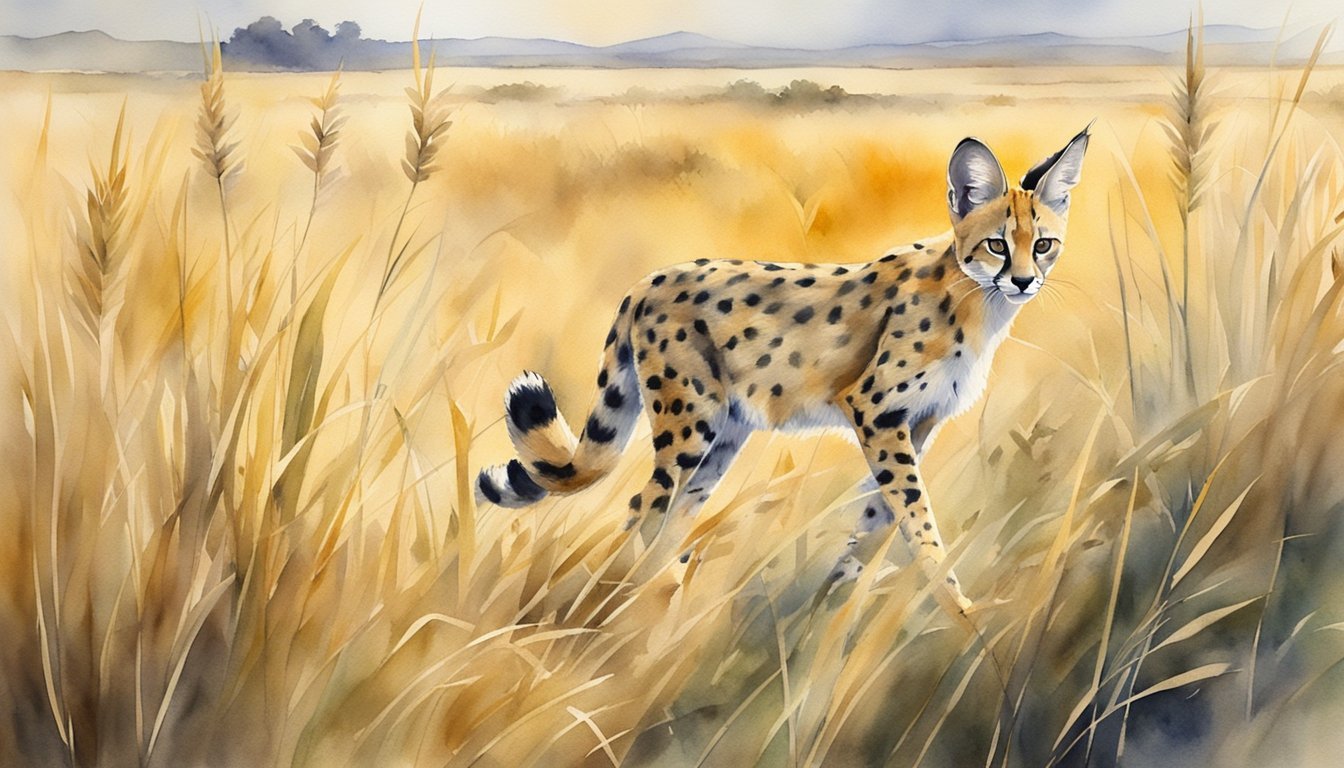Serval Cat Characteristics

The serval cat, scientifically known as Leptailurus serval, is a distinctive feline known for its peculiar physical features and unique behaviors. This section delves into the specifics of its appearance and its lifestyle in the wild.
Physical Description
Servals are medium-sized cats with some of the longest legs relative to body size among all felines. This slender physique aids in their ability to pounce on prey. They typically weigh between 20 to 40 pounds, with a body length of up to 85 centimeters and a tail length averaging around 40 centimeters. The serval’s coat is characterized by a yellow to tan color, adorned with black spots, bands, and stripes, which aid in camouflage. The serval’s ears are notably large and rounded, providing excellent hearing to detect prey even in tall grass. They have a small head and a long neck, which contributes to their unique silhouette.
Notably, the coat pattern of servals, which plays a role in their hunting strategy, is unique to each individual. The fur helps them blend into their environment, making them skilled hunters capable of delivering a powerful bite with their strong teeth. Servals have a longer gestation period than domestic cats, resulting in small litters of kittens that are spotted and born with blue eyes that later change color.
- Length: Up to 85 centimeters (body), 40 centimeters (tail)
- Weight: 20 to 40 pounds
- Coat Pattern: Spotted with black spots
- Ears: Large and rounded
- Lifespan: 10-20 years in the wild
Serval Behavior and Lifestyle
As a solitary wild animal, servals prefer to live alone except during the breeding season. Known to have a carnivorous diet, servals primarily hunt small prey such as rodents, which they can detect and dig out of burrows due to their exceptional hearing and long legs. The serval’s long legs not only allow for an efficient hunting strategy, such as high leaps and rapid sprints to catch prey, but also make it one of the few cats capable of seizing birds right out of the air.
The serval lives in sub-Saharan Africa and is considered a species of “Least Concern” by conservationists because of wide distribution and relatively stable populations. Nonetheless, their habitats are being threatened by human encroachment. Servals are weaned at an early age, teaching them independence and predator evasive tactics critical for survival in the wild.
- Lifestyle: Solitary, except during breeding season
- Diet: Primarily small rodents, occasional birds
- Behavior: Efficient hunters, capable of leaping and sprints
- Conservation Status: Least Concern
The attributes of the serval, from its unique spot patterns to its remarkable hunting tactics, make it an awe-inspiring wild cat species.
Serval Cat Habitat and Diet

The serval cat is predominantly found in the grasslands of sub-Saharan Africa, stretching from the central parts down to the southern regions. Their diet is quite varied, consisting primarily of rodents, small birds, frogs, insects, and fish, which underscores their adaptability and skill as hunters in the wild.
Hunting and Prey
Servals are adept predators with physical attributes that enhance their hunting efficiency. These medium-sized wild cats are characterized by their long legs and large ears, which facilitate hunting in tall grasses and listening for the faint rustle of prey. Their primary hunting technique involves precise vertical leaps to pounce on prey such as rodents, birds, and other small animals. Servals are also known to fish and consume frogs, indicating their ability to exploit various food sources within their habitat.
At night, servals employ their acute sense of hearing to detect and capture prey. The structure of their legs and body allows them to vault into the air and land with deadly precision. Instances of servals leaping to pluck birds from the air or swiftly capture fleet-footed insects are a testament to their versatility as predators.
Conservation and Relationship with Humans
Servals occupy a wide range of habitats, including savannas, grasslands, and wetlands, which can occasionally bring them into conflict with humans, especially when they approach populated areas or livestock. However, they are not considered to be major threats. Conservation efforts are in place to protect servals, with hunting regulations enforced in several range countries to prevent them from being killed.
The serval’s adaptability to diverse environments has played a crucial role in their survival, yet they face threats from larger predators such as leopards and hyenas. While some servals have been captured for the exotic pet trade, they are not domestic animals and require extensive outdoor enclosures, which mimic their natural environment to thrive. They are a regulated species, and the keeping of servals as pets is subject to legal restrictions in many countries, including the UK.

